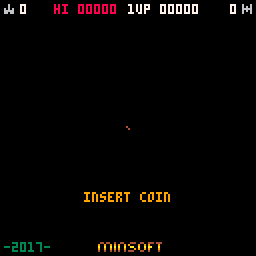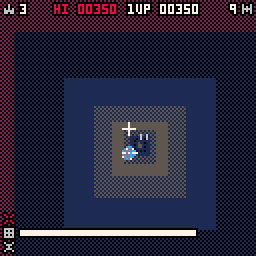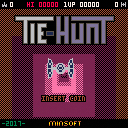Introduction
This is my homage to Owen Rubin's wonderful 1979 arcade game Tunnel Hunt, which features eye-wateringly fast psychedelic visuals and ominous sound. I have tried to retain the key elements of the game as best as I can (given smaller palette and lack of analog joystick), while adding a few variations to enhance to experience...

Gameplay
Hurtle through the tunnel blasting anything in your path. Your craft will increase speed over time, but hitting walls will slow it down (while also heating the hull). You can use this to your advantage, but overheating the hull will result in death!
Lasers will also overheat if used too much, which will disable them for a time until sufficiently cooled. Shields can be activated to defend against enemy craft or fire (plasma balls), but will be reduced in power as a result. Shooting plasma balls will charge your shields fractionally (as well as award 50 points).
There are four different types of enemy, which will require 1,2,5 or 10 shots to destroy. Points will be awarded based on the type of enemy destroyed, the time taken to destroy it, and enemy hostility (this increases over time). A bonus life will be awarded after 10,000 points, and every 30,000 points thereafter.

Controls
Insert Coin = Up / GPIO input (defaults to free play so not required!)
U/D/L/R - controls ship
(O) / Z - shield
(X) / X - laser
DIP Switches (menu items)
RESET HISCORE
CREDITS: FREE (default) / UP / GPIO }
GPIO OUTPUTS: OFF (default) / ON } NOTE altering these will reset game!
ATTRACT SFX: OFF / ON (default) }
Y-AXIS: NORMAL (default) / INVERT
GPIO Input / Outputs
IMPORTANT: GPIO pins are referred to by Raspberry Pi 'WiringPi' standards. See below for WiringPi configuration.
DISCLAIMER: I will not be responsible for damaging your device. Please do not enable GPIO settings, or connect anything to GPIO pins to anything if you are unsure what you are doing!
--- MINSOFT GPIO STANDARD --- PIN TYPE SETTING FUNCTION DETAILS 0 INPUT (PULL UP) CREDITS: GPIO Credit switch Connect switch between pin and ground (via optional resistor, eg 1k ohm) 1 OUTPUT GPIO OUTPUTS: ON Start/Warning LED Connect LED between pin and ground (via suitable resistor, eg 220 ohm) 2 OUTPUT GPIO OUTPUTS: ON Start/Warning LED Connect LED between pin and ground (via suitable resistor, eg 220 ohm) 3 OUTPUT GPIO OUTPUTS: ON Vibration motor Connect motor via suitable circuit (eg http://playground.arduino.cc/uploads/Learning/solenoid_driver.pdf) 4 OUTPUT N/A N/A N/A |
WiringPi Configuration
//set pin 0 as input, pull up (COIN) gpio mode 0 in gpio mode 0 up //set pins 1-3 as outputs gpio mode 1 out gpio mode 2 out gpio mode 3 out |

Nice! are you using pattern fills to do the dithering colors?

Really nice, I must admit it reminded me of another game (galaxy force for the Master system), that was an enjoyable experience ^^.

stephan_gfx: I am using a simple pattern fill, specifically:
fillp(0b1010010110100101) |
This feature was added at the right time for me!
Aphrorite: I've not played Galaxy Force on the Master System - I'll have to check it out!

Here's a little video showing the GPIO outputs in action:

Definitely not a game for players with epilepsy or claustrophobia but nice immersive effect achieved with the combination of graphics and sound.

This is amazing! Im in love with the idea of building an actual cabinet for this game! Keep up the great work!

Thank you, pleased you like it!
I'm making do with my tabletop Scramble (see my previous reply) but would also like to make a cabinet for Pico-8. Love the potential for doing cool stuff with the GPIO outputs!

This reminds me a lot of "Tunnels of Armageddon" which I'm more familiar with but this is far more enjoyable.

Thanks, I will have to give Tunnels of Armageddon a play. Not seen it before but the tunnel graphics look very similar. Cheers!
[Please log in to post a comment]











